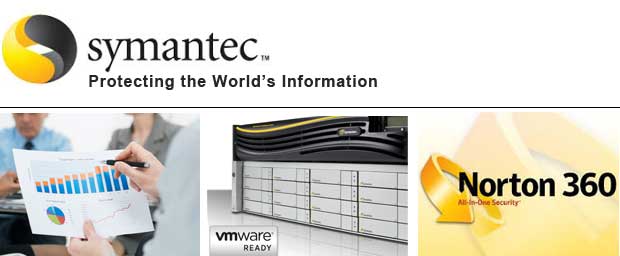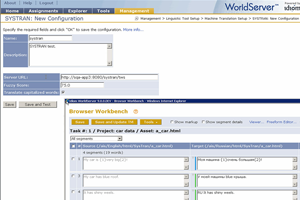Symantec - Case Study

Fortune 500 company with operations in over 40 countries and expanding
Translates over 20 Languages, more have been added since this case study
Results: Reduction of both translation costs and time
Robust API allowed easy integration
Symantec is a global leader in infrastructure software, enabling businesses and consumers to have confidence in a connected world. The company helps customers protect their infrastructure, information, and interactions by delivering software and services that address risks to security, availability, compliance, and performance. Headquartered in Cupertino, California, Symantec has operations in 40 countries.
Within Idiom WorldServer, the Fuzzy Score is set here to 75%. SYSTRAN automatically translates segments lower than this threshold. Translators review coloured segments within the Browser Workbench.
"Our main objective is to offer quality product documentation and technical support to our international customers in a cost effective manner. With the roll-out of our global content management system, we have control over our documentation production process. Our metrics show a 100% increase in word counts managed by our internal translation team since the introduction of SYSTRAN technologies into our localization process. Automated translation software is a powerful innovation when integrated into a streamlined translation workflow. It clearly boosts our globalization capacities."
Fred Hollowood & Orla Clifford, Global Language Services, Symantec.
Challenges
- International customers to service with a variety of content and formats
- Product documentation published in 20+ languages
- Technical Support content delivered in multiple languages
- To help and support international customers in their own languages
Solutions
- Integrate SYSTRAN Translation Technology with an online global content management workflow system
- Automatically translate with SYSTRAN no match segments in translation memories
- Product Documentation and Technical Support content in English, translated in French, German and Japanese
- Chinese, Spanish and Italian localisation as a second step
Results
- Personal productivity for internal translation team doubled
- A cost effective solution which makes it possible to increase volume of translated content
- Address translation projects with scalability and cost control
- Control terminology and streamline methodology to smoothly enable new language pairs
SYSTRAN Solution: Documentation and Localization

Within Idiom WorldServer, the Fuzzy Score is set here to 75%. SYSTRAN automatically translates segments lower than this threshold. Translators review coloured segments within the Browser Workbench.
A few minutes with Symantec
What are the main reasons that invoked your interest in machine translation for use within your Global Language Services department?
Symantec operates in more than 40 countries. As a leader in IT infrastructure, we deliver sophisticated products and services to international customers. As an international company, we focus on globalization early in the process. Our Global Language Services division addresses the needs of localized product documentation and technical support content. With multiple acquisitions completed in the last number of years, Symantec's globalization requirements are complex and diverse. Faced with these increasing needs, we chose to evaluate a rapid, cost-effective translation technology. Our goal is to reduce translation costs to 35% and reduce translation time by 66%, while maintaining quality standards.
Which content did you start your research of translation solutions on?
Product documentation and technical support content have to be localized for our customers. When the user reads product information in their own language, they gain a more comprehensive understanding of the product. Furthermore, customer support contacts are deflected to pre-published articles on the web, reducing the volumes of support calls. We started this process by evaluating the validity of applying machine translation to this content. Since then, we have also applied machine translation to other product support offerings such as product documentation.
Can you describe the first steps of your machine translation project?
We started this project by integrating SYSTRAN technology with Trados Translation Memory technology. Our internal linguistic teams quickly gained confidence in maintaining customer specific dictionaries and post editing. Indeed they doubled their personal throughput of translation content provision over the first six months of the project. After this initial success, we integrated MT with Idiom's WorldServer system and applied this model to all of our workflow enabled translation resources.
How did you choose SYSTRAN among the other competitors?
We chose SYSTRAN from among a range of MT technology suppliers for the following reasons:
- They provided a comprehensive language spread for global deployment
- The rules based approach allowed us to begin translation without significant engine training
- Their client-server based solution allowed centralisation of customer specific dictionaries in addition to general scalability
- The robust well documented API allows us to integrate this technology with other third party language technology tools.
- The customisability of the solution has allowed us to quickly tailor the technology and process to our various requirements.

Can you describe your customised solution for product documentation?
The basic idea is to use machine translation in tandem with a computer-aided translation tool. We never intended to 'replace' human translation but instead wanted to assist professional translators with innovative tools. We developed an application to link machine translation processes between SYSTRAN and Trados. We called it SymGlue (i.e. Symantec Global Language User Environment).
In short the process leverages existing translations from Trados TM's and then exports lower value or no match segments to a TMX file.
We then pass this file to SYSTRAN for machine translation and finally re-import the machine translated TMX file back into the Product Translation Memory. We have used this process on a variety of content including Product Documentation and Technical Support in a variety of languages, specifically Japanese, Simplified Chinese, French, German, Italian and Spanish. Underpinning this solution is a robust and well embedded practice among our Infodev writers of authoring content in a controlled way. We have deployed controlled language checking software (acrocheck) to help our writing teams in this practice.
What were your results once you introduced machine translation into your translation process?
In a very short time, the throughput of our internal translation team doubled from an average translation throughput of 1500 words per day to 3000 words. When applying this process to larger documentation sets we have aimed and achieved an increase in throughput of up to 60% in some languages.
With the roll-out of Idiom WorldServer in 2006 and the SYSTRAN integration with same, we expect to further increase our productivity. The integration of SYSTRAN and Idiom WorldServer give us a completely automated translation process. We gain control on delivery timing and have the potential to deliver ever increasing amounts of previously untranslated content.
How do SYSTRAN and Idiom WorldServer work together?
Both companies have extensive API's which facilitated their integration in our process. Future innovations in the development of both products will allow for an ever tighter, more seamless integration.
What are the points you appreciate in SYSTRAN translation technology?
Apart the overall good translation quality for the off-the-shelf engine, we appreciate the powerful customization capabilities within the SYSTRAN modules. With SYSTRAN Translation Style Sheets, we were able to manage Framemaker and XML specific tags within the product documentation content, neutralising the potential issue that they present to a MT engine. We are now starting to use this XML-aware technology to provide context sensitive translation based on XML tags or Framemaker elements. We are also interested by the new metrics proposed in SYSTRAN version 6, in particular the complexity and the confidence scores to have more control on the translation reliability and accuracy.
What are your conclusions on this project and your future expectations?
SYSTRAN technology as a productivity booster for localization gives significant leverage. Combined with a controlled language authoring approach which we have also adopted, we are making significant gains in reducing translation costs and increasing throughput. It is also clear to us that improving translation quality requires the maintenance of custom dictionaries to train the software with our specific terminology. We are always finding new opportunities to employ SYSTRAN technology within the corporation e.g. in the area of real time chat. We have also started to refine the automated translation with post processing actions based on pattern recognition. Across the various application areas that we are currently using this process, we expect to apply SYSTRAN to new language pairs in the future.

